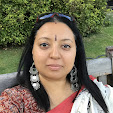The following is an essay on the "history of Egyptian Women" which hitherto, rests on a simple distorted reality . Throughout the years, we have been taught in school an extreme and narrow version of our actual history, which has been written basically with "Ahl al-zawat" or al-khasah (people of good stock, or the Aristocracy) in mind. Actually this group, though vocal and affluent, represented only a minute section of the Egyptian society and therefore could not be considered a true repesentation of the whole of Egyptian society. Historians, both Egyptians and especially foreigners, are simply oblivious of the true history of the majority of Egyptians or `amat al-sha`b. The latter, representing a major group of people whose history is seldom breached or adequately explored. For example, when dealing with subject matter such as "Egyptian Women's Liberation", and the Veil or the lack thereof, we traditionally tend to talk about the roles of the likes of Huda al-sha`rawiy, Qasim Amiyn, etc. Anything else falls by the wayside and/or is conveniently swept under the rug. As a result we end up with a "Parallel universe" or "alternate reality" version of our history which is a self-contained separate reality coexisting with our own, but not necessary a true reflection of our own world. The following essay entitled, "The World of Na`sah," is not about validating whether or not an Egyptian woman should wear the veil. Rather, it is about the true reality of the life of a typical Egyptian Fallahah, living at the turn of the last century. Hopefully, her harsh living conditions and abject poverty will illuminate our understanding of this complicated subject matter. Na`sah is a mother of four. Who, along with her husband and children, lives in a typical Egyptian village. This is her story. In the village where Na`sah lives, mud is used as a building material. Her village borders a filthy artificial pond (mustanqa`) from which mud for bricks is dug. In a cluster of such huts, along a branch of the Nile, lives Na`sah and her family including her husband `Uways and their four surviving children (five others died in infancy). The mud huts of Na`sah's village huddle tightly together near the river, some of the houses sharing a common wall. Stretching out in three directions behind the village are lush green fields, beautifully laid out in crops of cotton, corn, beans, or clover, intersected by irrigation canals. These crops are carefully rotated from season to season. The village itself is bare, except for a single cluster of gracefully swaying date palms. The "lanes" between the huts are ankle-deep in dust and pulverized dung, teeming with fleas, lice, bedbugs, flies, and mosquitoes. Her house has a wooden frame door, but otherwise it is made exclusively of mud and straw. An external staircase leads to the flat roof, where Na`sah squats to pat camel dung into flat discs to dry in the sun and later to use as cooking fuel. When you enter the house proper, you step into a rather large reception room, running the width of the building which Na`sah and her husband `Uways and her children share with their animals. At one end, Na`sah cooks over a mud-plastered oven called tannuwr and/or kanuwn, and somewhere towards the center, `Uways her husband and his male guests sit on a straw mat sipping, shayy Kushariy bil ni`na`, heavily-brewed tea with mint. Their only source of social intercourse is spending their spare time, in the evening,gossiping. Occasionally Na`sah will interject herself in the conversation with her husband's guests and contribute with her comments if the subject matter concerns the family or topic of marriages. At the other end of the room is a motley assortment of chickens, a sickly, one-eyed kitten, two geese, and a goat. The queen of the animals in the house is the gamuwsah, the beautiful bluish-black, broad-backed water buffalo, the Fallah's chief work animal and provider of milk, yogurt, and white cheese. Na`sah and her husband get their rare bit of cash from selling the calf the gamuwsah produces yearly. Keeping these animals inside the house means that the dirt floor is littered with animal dung of every description. But the family cannot take a chance on them being stolen, and Na`sah never considers her animals secure unless they are locked inside the house with the family. The loss of a gamuwsah is of a traumatic consequence to any peasant family and hence is treated as the equivalent of a member of the family. No wonder this is a serious matter on which all Fallahiyn are adamant; the animals-must live inside the house. Losing a gamuwsah amounts to a death in the family. This peasant family dresses simply. `Uways wears a full length cotton gown called a gallabiyah and usually a skullcap on his head. Sometimes, he winds a white turban around the cap. His four children dress like miniature `Uwayses, in little gallabiyahs (gallaliyb) and knitted caps and, like their father, all are barefoot. Na`sah drapes herself in a black sheet "milayah" and/or tarhah covering her head and falling on her shoulders, underneath which she wears a headscarf "mandiyl" bi tirtir (a sheer black or colored headscarf adorned with sequins). Her dress is a black or colorful cotton gallabiyah. She does not wear a veil (1) and wears her hair in braids (dafa`iyr) hanging down her shoulders. Within village life, she is NOT segregated (see picture below). Anyone who has intimate knowledge of the village knows that both sexes in rural families have to work closely together and therefore segregation would be unworkable and unthinkable.  Exigencies of life have taught Na`sah to be practical. Though, like her husband, she is illiterate, she knows how to make herself useful. She works hard beside her husband `Uways in the fields. She goes into the rice paddy, grabs her gallabiyah from the back hem, pulls it through her legs to the front and tucks it in, her legs are visible up to the thigh. Not far from her, `Uways and his neighbor Hammuwdah strip and wade into the water. Egypt's rice output at the dawn of the 20th century (1905-1909) toped 1,020,000 ardabs. The crop is entirely credited to the Egyptian Fallahat (women peasants). Thanks to the gifted hands of a woman, the Fallahah is an essential part of the Egyptian agriculture work force. Her additional contribution in harvesting the legendary Egyptian cotton, which hits a record output of 6,372,000 qintar, is credited to her expertise and delicate picking of the cotton blossoms and extracting the seeds from them. All her children bathe in the filthy irrigation canal, while Na`sah squats in the mud on the bank and does the family laundry. For cooking and drinking, the long-suffering Na`sah carries water to the village in a pottery jar (Ballas) which is neatly balanced on her head. She has to walk hundreds of yards back and forth, and with every load of water, she unknowingly carries a fresh injection of disease to her family. Na`sah, and some ten million Fallahiyn (2) like her, knows so little of sanitation that in the early 1900's they are among the most diseased people on earth. It is little wonder that half their babies die before they reach the age of six. Debilitated by disease, the Fallah mechanically and monotonously does his farm work in a pattern laid down by his ancestors. At night, `Uways and his family leave the animals in the big room and withdraw to the small bedrooms in the rear of the house. A rare moment of wealth, found Na`sahanxious and nervous for fear that her husband might take another wife. But thanks to God, `Uways instead has bought her an iron-posted bed in which both sleep. Before that, the whole family, including the children, shared straw mats on mud ledges projecting from the walls. Na`sah is relieved this time, and thanks God for her husband’s choice of an iron-posted bed and not another woman, but still she cannot totally rid herself of the fear of abandonment. Because Na`sah, deep inside her, knows that the Fallah in general counts his wealth in children, and no amount of statistics can convince him that there should be any limits to the number of his offspring. Na`sah is saved from sharing her husband with another woman by the stark economic facts of life facing her husband. `Uways rents three acres of land from the owner of his village, and that tiny plot barely keeps the family alive. The silt-laden Nile provides water for this family's drinking, washing and cooking. This murky water is literally crawling with tiny marine life, but Na`sah, like her ancestors in ancient times, swears by this water as a nutritious beverage. For six thousand years, the Fallah's biggest problem has been getting water to his thirsty fields, and through the ages he has used the same methods of irrigation. It is a literal truth that a Fallah is strong and relatively healthy if he has only one disease. The vast majority have at least one chronic eye disease and one chronic intestinal. Snails in the canals carry the parasite of bilharzia, a debilitating internal disease said to reduce Egyptian productivity by at least a third. Sixty-five to eighty-five per cent of the Egyptian population is infected with bilharzia, and there is little hope of getting rid of the disease so long as the fallahiyn drink, bathe, and work in infected canals. Amebic dysentery in varying degrees of intensity is well-nigh universal in the villages, and trachoma and opthalmia are widespread. Undernourished Egyptian peasants are an easy prey to typhoid, malaria, and tuberculosis. The average span life of a Fallahah in the early 1900's is 40 years, her male counterpart is 38.6. Glimpses of ancient Egypt are present when she follows her husband among the furrowed fields scattering the seeds, or at harvest time when she throws the grains against the wind into the air with a winnowing fork, the chaff blown away and the wheat remaining. Or when the blindfolded gamuwsah walks tirelessly around and around to tread out the grain on the threshing floor. As years pass away, the more children she has the less each member of the family has to eat. For in general, the Fallah's production, low as it might be is going largely to others. Na`sah's family rarely work their own land, they sharecrop, rent or work by the day on the land of Egypt's fabulously rich landlords, who have the Fallahiyn at their mercy. Na`sah realizes that her family has being working all their lives to provide a life of incredible luxury for those strong enough to usurp the land. Overwhelmed by poverty, ignorance and disease, and quite ignored by the enlightened members of the society, Na`sah is still resilient and endowed with remarkable fatalism and patience. She leans upon her husband's shoulder and gazes out onto the land, the emptiness of the ages in her face, and on her back the burden of the world. In my opinion, any fair assessment of empowerment of women's material and spiritual development in the Egyptian society ought to be carefully measured against how far and how deep the world of Na`sah has changed to the betterment not only of women's condition, but to the peasant life in general. No matter how much prosperity came to Egypt, very little of it really trickled down to Na`sah's world. While the so called feminist movement concentrated on symbolic gestures such as discarding the Yashmak (the arstocratic Turkish version of a veil), the movement was completely anesthetized in one respect. It failed to understand that Na`sah could not read the tracts written by the movement in French. Instead what Na`sah really needed was a pair of sandals or shabashib to enable her to walk free of disease to the nearest school. According to a Chinese proverb: "The journey of a thousand miles begins with one step." Preferably wearing comfortable footwear, I should add. Ishinan
(1) See above photos, vintage of late 19th- early 20th c. and a drawing by T. W. Holmes from the middle of the 19thc. (2) total population of Egypt in the pre-war period 1904-13, was averaging between 10,484,000 - 11,998,00. At that time 90% of the population lived in rural areas.
Ishinan © Copyright 2001 |
































No comments:
Post a Comment